Talk to a Registered Dietitian and use INSIDER20 for 20% off!
Talk to a real Dietitian for only $99: Schedule Now
This post contains links through which we may earn a small commission should you make a purchase from a brand. This in no way affects our ability to objectively critique the products and brands we review.
Evidence Based Research To fulfill our commitment to bringing our audience accurate and insightful content, our expert writers and medical reviewers rely on carefully curated research.
Read Our Editorial Policy
From the deep blues and purples of berries and eggplant to the vivid reds and oranges of watermelon and sweet potatoes, pigmented antioxidant compounds create the rich hues of the natural food we eat.
But they don’t just help fruits and vegetables look pretty—antioxidants are vital to maintaining proper cellular function, which translates to health benefits.
But what are foods high in antioxidants? If you’ve ever wondered what compounds cause beets to stain your hands or how berries got to be so vibrant, this article is for you. In it, we’ll detail the top antioxidant-rich fruits and vegetables, the colors they create, and their health benefits.
First things first: what are antioxidants, anyway?
As the name (anti-oxidant) suggests, these compounds fight oxidant compounds such as free radicals or reactive oxygen species (ROS).
Although free radical production occurs naturally in the body (like when our mitochondria turn food into fuel), problems arise when they are produced in excess and cannot be properly neutralized.
This accumulation of free radicals leads to a state known as oxidative stress, which causes cellular and DNA damage, ultimately leading to chronic disease and accelerated aging.1
Oxidative stress can be caused by excess free radical production or inadequate antioxidant input. Free radicals are produced from both healthy activities—including exercise and sunlight exposure—and unhealthy ones, such as poor diet, smoking, toxin exposure, pollution, stress, alcohol, pesticides, and obesity.2
On the flip side, antioxidants can help to neutralize excess amounts of harmful free radicals.
To describe how antioxidants work requires a bit of time travel back to your Chemistry 101 class. Briefly, free radicals are “electron stealers,” meaning they will take an electron from anything nearby, no matter what it is. This can drastically alter the makeup of the substance the electron was stolen from, including changing the instructions coded in a strand of DNA or damaging a cell’s membrane.1
This is where antioxidants come in: they give their extra electrons to free radicals, so they don’t have to go scavenging around our cells and DNA to find one. Essentially, antioxidants are like a good Samaritan who gives a robber on the street their own money before they steal from and injure an innocent bystander.
There are many types of antioxidants found in plant foods, including polyphenols (like anthocyanins, phenolic acids, and flavonoids), carotenoids (like beta-carotene and lycopene), vitamins (like vitamin C and vitamin E), and minerals (like selenium and manganese). Other antioxidants are produced inside the body, like coenzyme Q10 and glutathione.3 While trials with antioxidant supplements have produced mixed results, food-based antioxidants are thought to benefit health much more, likely due to their synergistic effects with the other micronutrients and compounds found in the plant.4 Now, let’s dive into the colorful world of antioxidants.
Three primary pigmented antioxidants produce red or pink colors in food: lycopene, astaxanthin, and betalain.
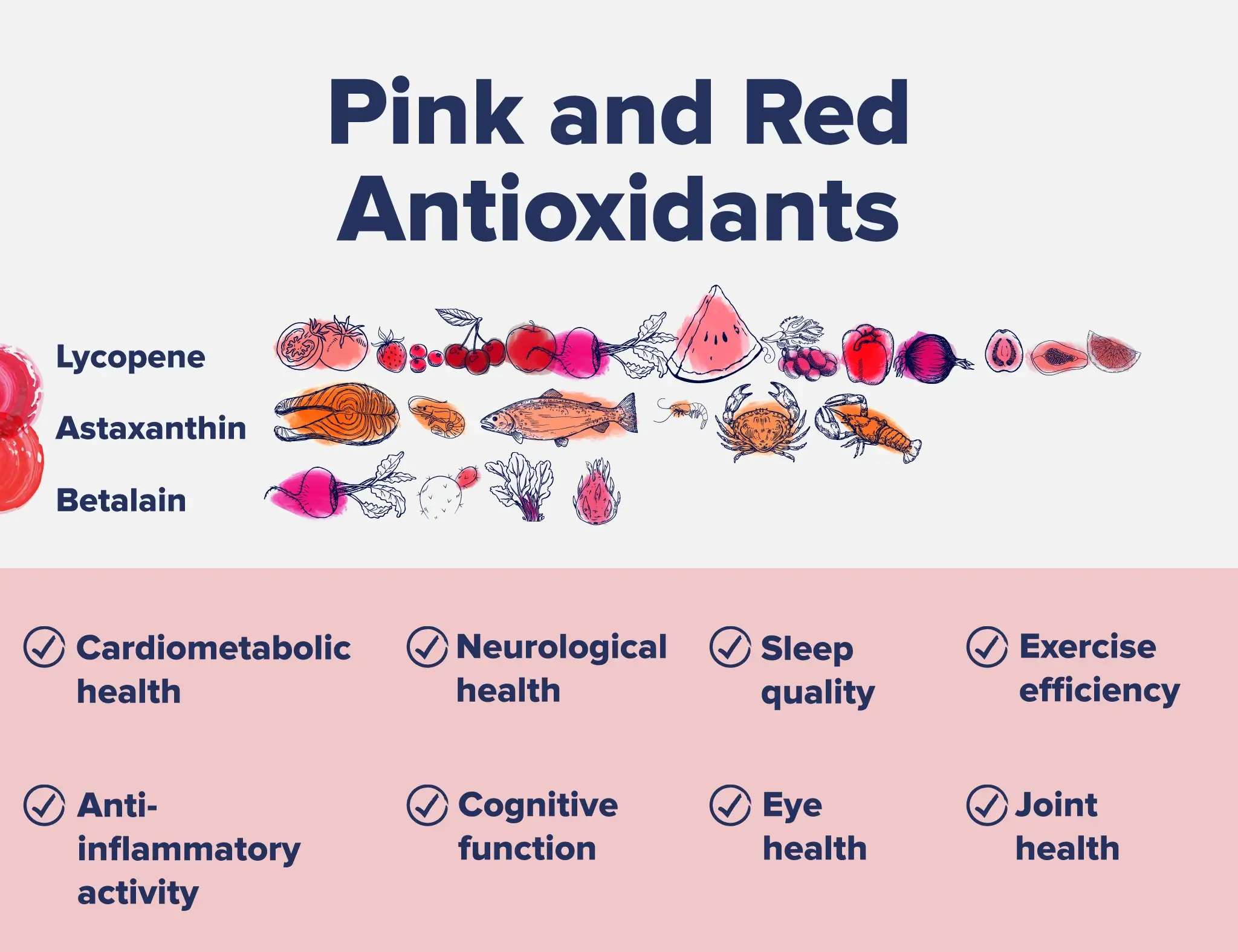
Lycopene is a carotenoid antioxidant that produces red and pink pigments in a wide variety of fruits and vegetables.
Tomatoes are the most commonly known lycopene-containing food, but this carotenoid is also found in strawberries, cranberries, cherries, red apples, beets, watermelon, red grapes, red bell peppers, red onions, guava, grapefruit, and papayas.
As a quick side note, the lycopene content of cooked tomatoes is greater than raw. Tomatoes that have been cooked for just two minutes have 54% more lycopene than raw ones while cooking them for 30 minutes boosts lycopene by 164%.5 Adding olive oil also increases lycopene bioavailability.6
When it comes to the benefits of lycopene, its biggest claim to fame is its role in prostate health.
Research has found that lycopene consumption is linked to reduced cancer risk in the prostate due to its antioxidant and anti-inflammatory activity.7 Along the same lines, lycopene has shown promise in lab studies for reducing the growth of breast cancer and colon cancer cells.8
In addition to its anti-cancer effects, lycopene is also linked to:9
Astaxanthin is a unique carotenoid, as it’s one of the only ones found in animal foods. If you’ve ever wondered how salmon and shrimp got their pink coloring, astaxanthin is the answer.
In addition to salmon and shrimp, astaxanthin provides trout, krill, crab, and lobster with their pink and red hues.
But it’s not naturally produced in the animals—astaxanthin is made by algae and bacteria that get eaten by fish and seafood, moving up the food chain and changing the color of their flesh. It also gives flamingos their pink coloring, as the birds consume astaxanthin-rich algae.
Research has found that astaxanthin may have higher antioxidant activity than other carotenoids, which may explain its multitude of health benefits. It also protects mitochondrial function and reduces the activity of pro-inflammatory signaling molecules called cytokines.10
Some of the leading evidence-based benefits of astaxanthin include:
As you might guess from its name, betalains are found in red beets, producing that bright red color that makes your kitchen look like a crime scene after you’ve finished cutting them.
In addition to red beets, just a few other foods contain betalains, including prickly pear (cactus fruit), rainbow chard (Swiss chard), and pitaya (dragon fruit).
The primary benefits of consuming betalains are related to the cardiovascular system. They have shown promise for lowering lipid and cholesterol levels, managing blood sugar, and reducing obesity.16
While astaxanthin and lycopene are the carotenoids that produce red or pink pigments, most other carotenoids produce orange or yellow colors.
There are several types of orange-pigmented carotenoids, including alpha-carotene, beta-carotene, lutein, and zeaxanthin.
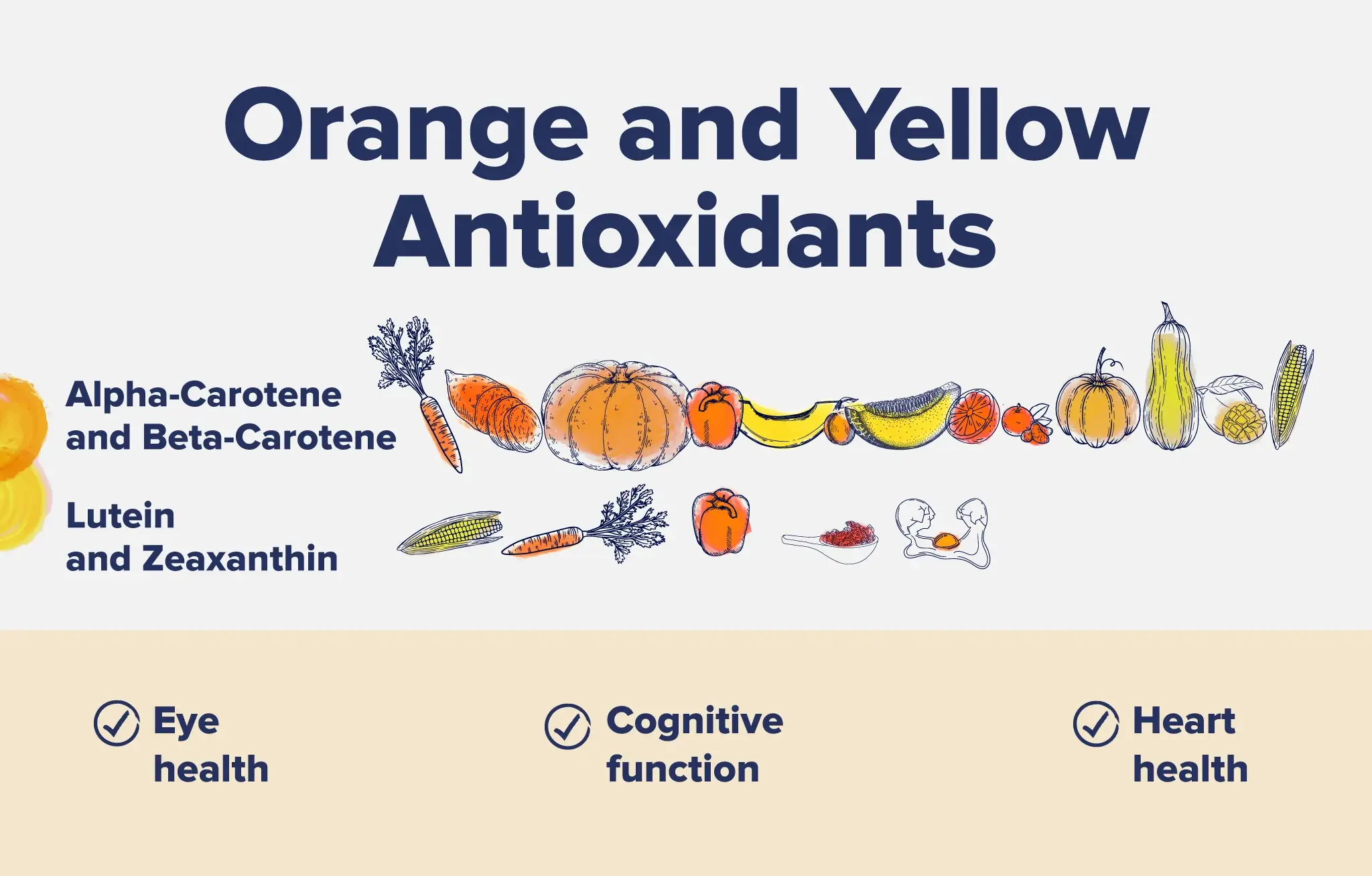
Alpha-carotene and beta-carotene are considered pro-vitamin A carotenoids, meaning they can be converted in the body to vitamin A in the form of retinol.17
You can find these two carotenes in carrots, sweet potatoes, pumpkin, bell peppers, melon, apricots, cantaloupe, oranges, tangerines, acorn squash, butternut squash, mango, and corn.
They’re also found in some green vegetables, like spinach, kale, and broccoli, but the chlorophyll in these green plants overpowers the orange-red pigments.
Beta-carotene has been studied more than alpha-carotene, and its benefits include improved vision, heart health, and cognitive function.17,18
Lutein and zeaxanthin are xanthophyll carotenoids that also impart an orange-yellow color to plants. (Side note: Xanthophyll is the pigment that causes those beautiful color changes in autumnal trees!)
Lutein and zeaxanthin are commonly grouped together in research and dietary supplements, as they are both highly concentrated in the eye.
The prominent orange foods containing lutein and zeaxanthin are corn, carrots, bell peppers, goji berries, and, uniquely, egg yolks. Like the other carotenoids, these two are also found in dark green vegetables like parsley and kale.
Lutein and zeaxanthin are known for their role in eye health, as they are the only dietary carotenoids that pigment the yellow spot of the retina.19
This allows them to scavenge for free radicals in the eye and protect the eye’s macula from light and oxidative damage. As a result, lutein and zeaxanthin are thought to reduce the risk of age-related macular degeneration and cataracts.19
In addition to vision and eye health, lutein and zeaxanthin have been studied for their role in preserving cognitive function with age.20,21
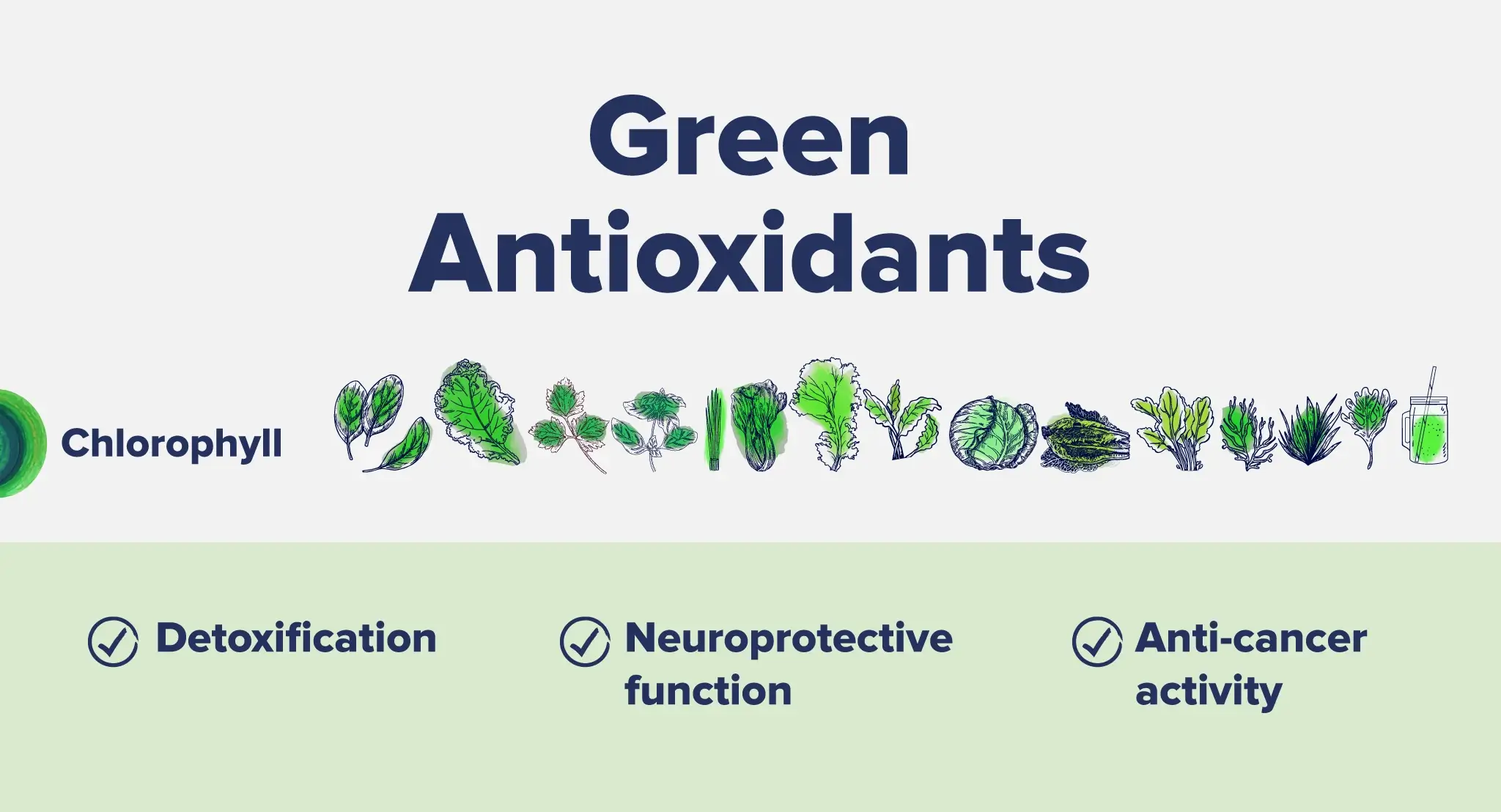
You may remember chlorophyll from elementary school science class for its role in photosynthesis—and it also gives all green plants their color.
Foods containing chlorophyll include spinach, kale, parsley, basil, wheatgrass, bok choy, lettuce, beet greens, green cabbage, collard greens, Swiss chard, algae, spirulina, seaweed, and matcha green tea.
In addition to its antioxidant properties, chlorophyll also helps with our natural detoxification pathways and exhibits neuroprotective and anti-cancer activity.22
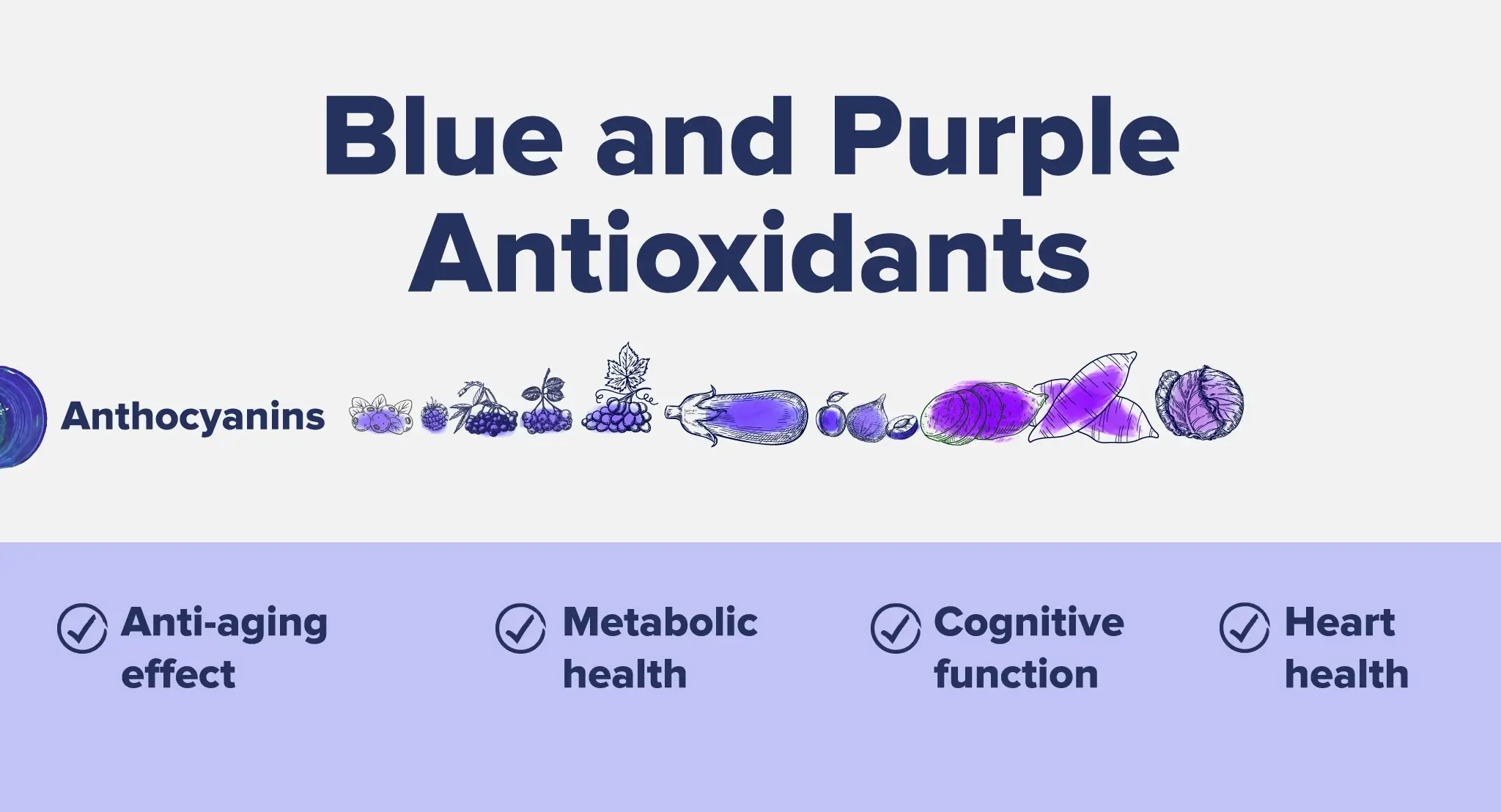
Some of the most powerful antioxidants in food are anthocyanins, providing plenty of fruits and vegetables with dark blue, purple, or almost-black coloring.
Anthocyanin-rich foods include blueberries, blackberries, elderberries, chokeberries, grapes, eggplant, plums, figs, prunes, purple sweet potato, ube, and purple cabbage.
These antioxidants are the ones most associated with anti-aging, metabolic health, and cognitive function.23
Some research has found that greater anthocyanin intake is linked to better metabolic function and lower body weight. One study of twins found that those consuming more anthocyanins had a 3 to 9% reduction in fat mass and less central adiposity.24
Anthocyanins are also particularly beneficial for reducing the risk of heart disease because they improve vascular function, including increasing vasodilation (blood vessel dilation) and reducing damage to endothelial cells.25
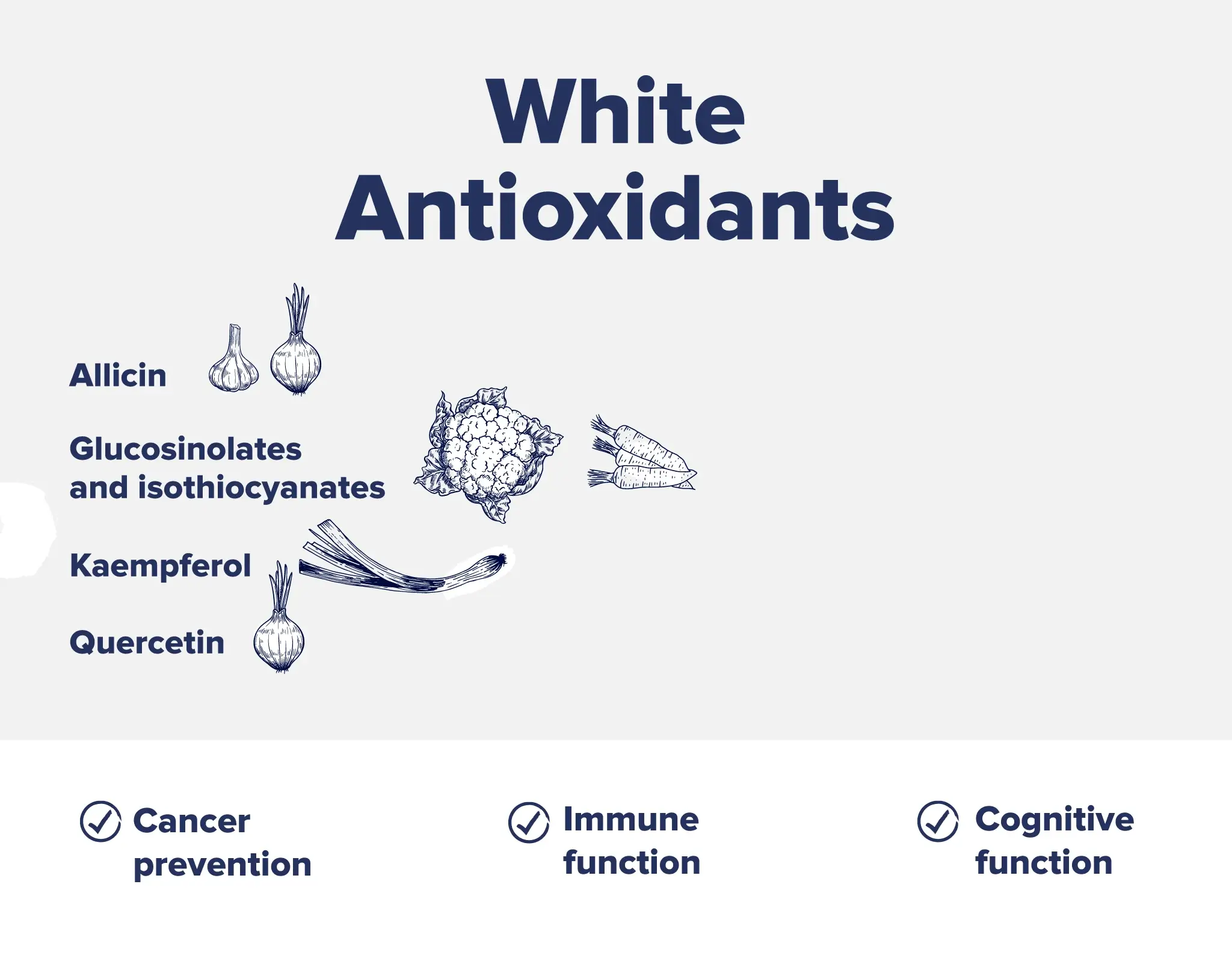
The antioxidants found in white or beige foods are non-pigmented—this makes sense, as these veggies are white! However, these are worth mentioning as they have some pretty great health benefits.
Some of the top antioxidant-rich white foods are garlic, onions, cauliflower, leeks, and daikon radish.
The allium family, including garlic, leeks, and onions, contains allicin—an antioxidant with powerful properties for cancer prevention. Allicin has also been studied for its role in preserving cognitive and immune function.26,27
One important tip for maximizing the benefits of allicin is to let minced or sliced garlic rest for 10-15 minutes before cooking with it.
Beneficial antioxidants will be destroyed if you mince garlic and immediately throw it into a hot pan. Raw whole garlic does not contain active allicin, but when you mince, cut, or press it, the two inactive ingredients come into contact and form allicin.
This process takes about 10 to 15 minutes. An easy solution is to mince your garlic as the first step in your cooking process and let it sit on the counter for a bit, allowing the anti-cancer and antioxidant-loaded allicin to form completely.
Other white-food antioxidants include glucosinolates and isothiocyanates in cauliflower, kaempferol in leeks, and quercetin in white onions.
There are many types of antioxidants found in plant foods, including polyphenols (like anthocyanins, phenolic acids, and flavonoids), carotenoids (like beta-carotene, lutein, and lycopene), vitamins (like vitamins A, C, and E), and minerals (like selenium and manganese). Other antioxidants are produced inside the body, like coenzyme Q10 and glutathione.
The most powerful endogenous (produced in the body) antioxidant is glutathione, which is referred to as our “master antioxidant.” Regarding food-based antioxidants, astaxanthin is known to have excellent antioxidant activity. Anthocyanins are also quite powerful. However, all of the plant-based antioxidants are beneficial for various aspects of health.28
From supplements, yes, you can have too many antioxidants. In general, it’s recommended to get your antioxidants from food sources rather than from dietary supplements. You probably won’t be able to reach excessive doses of antioxidants from food alone, but supplements are more concentrated. Excessive amounts of antioxidant supplements could interfere with essential cellular defense and signaling functions and actually harm health. Some research even shows an increased risk of death and lung cancer from taking beta-carotene supplements.29,30
There are so many benefits to eating the rainbow—aka filling your diet with foods from every color (Red Dye 40 and Yellow 5 excluded). Antioxidant-rich foods reduce free radicals and oxidative stress in the body, which translates to the prevention of chronic diseases—especially cardiovascular disease and cancer prevention. Each color of the rainbow imparts different health benefits. For example, orange and yellow produce is most associated with vision and eye health, while blue and purple fruits and veggies are linked to brain health and anti-aging. Eating a diet full of naturally occurring antioxidants may improve your cardiovascular, eye, skin, metabolic, brain, prostate, and joint health and reduce your cancer risk.